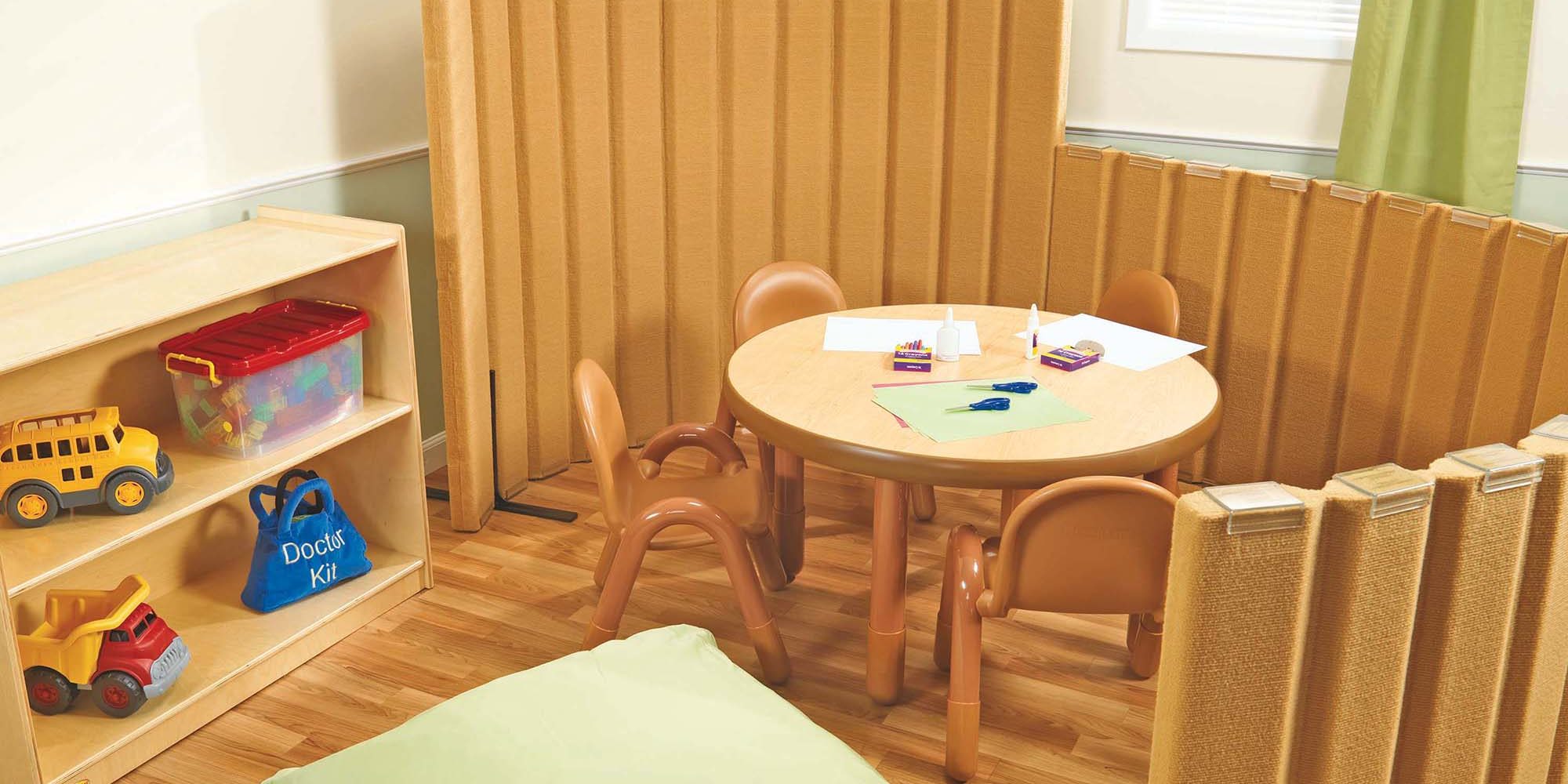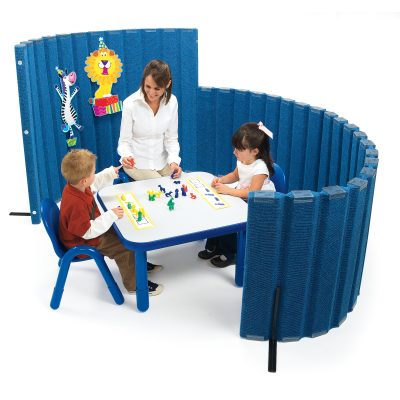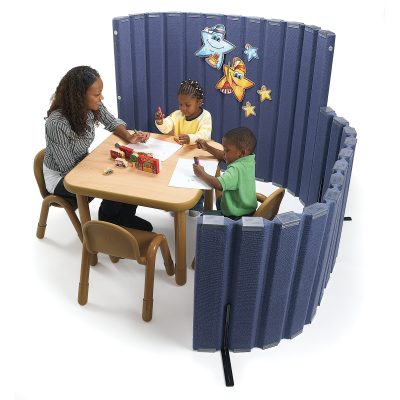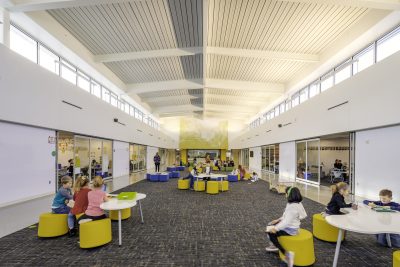
Can Classroom Design Affect Learning?
Classrooms designed with stimulation, individuality and naturalness in mind often have a positive impact on learning. According to research conducted by Peter Barrett, PhD, DSc, Faye Davies, PhD, Yufan Zhang, PhD, and Lucinda Barrett, PhD, naturalness accounts for about 50% of the impact whereas individuality and stimulation account for about 25% each.

Constructed with sound dampeners covered in hook compatible material, kids can take ownership of spaces by adding artwork and other displays to Quiet Dividers.
10 Key Classroom Design Parameters
When examining the main principles from their research, 10 key classroom design parameters seem to have the most profound effect on learning:
- Complexity
- Color
- Ownership
- Flexibility
- Connection
- Light
- Sound
- Temperature
- Air Quality
- Links to Nature
Stimulation pertains to classrooms where the appropriate amount of color and complexity is used in classrooms. Spaces need to capture the attention of children. Color is one way to achieve this goal. Complexity measures how visual elements combine to create a coherent and structured environment or one where randomness and chaos is the result. Kids thrive with the right level of complexity and their learning can be hindered when schools and teachers don’t hit the mark.

Quiet Dividers with Sound Sponge help promote design principles, like individualization, so kids learn more effectively.
Individualization refers to spaces intentionally designed for kids to take ownership. These spaces are personalized with the help of the students. The best classrooms are also characterized by flexibility to address the specific needs of an age group. Additionally, these spaces exhibit a high level of connection between students and the rest of the school.
Naturalness blends together light, sound, temperature, air quality, as well as links to nature in classroom environments for physical comfort. Light can affect sleep/wake cycles. Noise in classrooms, whether experienced from other students or from a lawnmower outside the room’s window, can hinder students from learning. Experts have identified many schools share some inadequacies. Less than optimal ventilation and excessive noise levels are quite common. By lowering the temperature slightly and increasing ventilation, many children have benefited according to research.
Focus on Physical Elements Within Our Control
Some physical elements are controllable, but many are not. Temperature is often static throughout schools, which means it’s out of each individual teacher’s hands. If you have the option to control the temperature in your individual classroom, dialing down the air-conditioning a few degrees can have a positive impact on your littles. Will you be cold? The possibility exists many teachers will need to wear a sweater more often if they want their kiddos to have the best possible learning environment. It’s hard to keep everyone 100% happy. It’s easier to put on a sweater, when rooms are slightly cooler, than for those who are too warm to find comfort.
Classroom Design Using Quiet Divider® with Sound Sponge®
Dampening the noise from other students and antics occurring outside the classroom is achievable. Sometimes it’s as simple as closing the door to drown out noise in the hallway. Other times it’s not so straight forward. Quiet Dividers with Sound Sponge are room partitions Angeles® developed to keep noise down in smaller flex-spaces within larger classrooms. These dividers absorb the noise so little ones can concentrate!
Quiet Dividers Promote Individualization
These room dividers can be used to encourage children to take ownership. Quiet Dividers are constructed using hook compatible material. Kids can be placed in charge of designing displays or hanging artwork directly on the room dividers. When they have directly participated in decorating their spaces, they will become more vested in preserving the beauty of the space.
Quiet Dividers Heighten Flexibility
Quiet Dividers are available in multiple sizes and colors. Built in magnetic connectors give classrooms the flexibility they need to maximize learning potential. Attach panels to each other in different ways using these magnetic connectors to create spaces customized to suit the specific activities. Redesigns are achieved just as quickly and easily. These room dividers are also free-standing, which means teachers and caregivers can place them anywhere in a room with no walls needed for support.
Fibonacci, Connection & Classroom Design

(Image: J.R. Irvin Elementary School in Midlothian ISD) Huckabee Architecture designed the J.R. Irvin Elementary School with the classrooms surrounding a central common space.
Teachers can’t just whip out their DIY skills and knock down some walls to connect classrooms to the rest of the school. Connection, therefore, is not always controllable. Why not use Quiet Dividers in creative ways to keep kids more profoundly connected? By placing the dividers in semi-circles with the openings all facing towards the center of the room where the teacher’s desk is located, kids will stay connected visually with many small groups and the main teacher’s desk.
At the J.R. Irvin Elementary School, Huckabee Architecture designed the classrooms to flank a centralized common space. Each classroom features a sliding, glass wall of doors to keep students visually connected to the rest of the school. In this case, teachers would position Quiet Dividers with the openings facing the centralized common area to create small group spaces and reduce noise.
Classroom Design, Naturalness & The Golden Ratio

The Golden Ration can help kids learn about STEM subjects
Creating spaces with Fibonacci curves can inspire the connection to nature little ones need to learn. Many room dividers are stuck in an unnatural state of squares and angles. Fibonacci’s Golden Rule is seen everywhere in nature from a snail’s shell, to a nautilus, the curved horns of a big horn sheep, a leaf on a giant fern, the petals of the center of a sunflower (or any other flower), or the way a pinecone is spiraled. Quiet Dividers divide spaces in a curved way where nature is truly brought into the classroom. Use your classroom design to introduce kids to STEM learning and how it is connected to nature.
See Quiet Divider® listings on Children’s Factory’s Amazon Store.
References:
http://usir.salford.ac.uk/id/eprint/33995/1/BAE-D-14-01430R1_Schools_paper_as_accepted.pdf